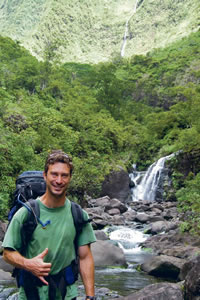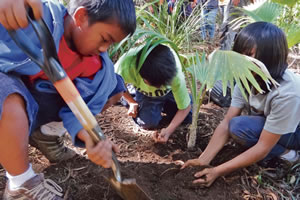Giving Native Species A Fighting Chance

Kaua‘i’s Forestry and Wildlife Area Reserve manager Michael Wysong on the job. Photo courtesy Michael Wysong
Michael Wysong leads the fight to remove alien plants and replace them with native species, and the results have been encouraging
Michael Wysong spends his days protecting the island’s sensitive habitat and restoring native ecosystems.
As Kaua’i division of Forestry and Wildlife’s Natural Area Reserve manager, he builds fences in designated habitats to keep out invasive species and regenerate native plants.
“It’s not rocket science when it comes down to it. It’s pretty simple stuff,” he says.
But while it may not be complex to understand, the beneficial impact of what he does for the ‘aina is monumental.
Thus far, results have proved successful.
One of the sites designated for protection is a small enclosure in Kuia that was fenced in and replanted approximately two years ago.
“We’ve been really surprised to see how much natural regeneration is coming back already,” says Wysong. “You can see the difference when you look inside versus outside.”
The first step in the process of area reserve protection involves erecting a fence to keep animals like pigs and goats from trampling on the freshly planted native species.
Fencing can be one of the most difficult aspects of the program. It takes a lot of planning and knowledge of the island’s rugged terrain.
“You can’t just put a fence anywhere,” he says. “You have to be very precise and know the area really well in order to determine a fence line.”
Once a site is determined, materials are flown in by helicopter, and the program’s staff of seven, along with any volunteers willing to pitch in, help build an approximately 7-foot-tall enclosure.
The removal of invasive plants, such as guava and lantana, within the enclosure are the next step in the progression.

Kaua‘i keiki plant native species in a designated reserve area. Photo courtesy Michael Wysong
Finally, endemic Hawaiian species such as koa and ‘ohia are planted.
Recently, a group of children assisted with replanting in several small areas, less than one acre, off of Nualolo Trail in Koke’e.
Education is part of the many things for which Wysong takes responsibility in his position. Among the knowledge he shares with others is that some 90 percent of the native plants in Hawai’i are endemic to the Islands and found nowhere else in the world. Dozens are on the brink of extinction.
“Once those go, they’re gone forever,” says Wysong, who previously worked for the National Tropical Botanical Garden.
On Kaua’i, 55 endemic species have less than 50 individual plants remaining in the wild. In dealing with a small, closed ecosystem like an island, threats are heightened and the situation becomes more intense. The state has nearly 50 percent of the endangered plants in the United States but only .06 percent of total land mass.
“Nowhere else in the world comes close to the amount of endemism that we have,” says Wysong. “And we’re also the endangered species capital of the world. That’s not a very good title to have, but it just means that the threats here are accelerated more than they are anywhere else in the world.”
Combating invasive species is no easy feat. In unfenced areas, ungulates like pigs degrade the habitat when they dig for earthworms and roots.
“They’re basically little mobile rototillers out there,” says Wysong.
And goats are voracious eaters that are particularly damaging to the forest.
“Not only will they eat the understory, they’ll eat the shrubs and the small plants and the seedlings of the trees. They’ll also eat the bark off of native trees, thereby killing the tree,” he says. “If you have a period over time where the understory has been completely grazed and you’re eating the seedlings that’s all the keiki for the forest you break that cycle of regeneration.”
Removing invasive plant species from designated protected areas also can be challenging. There could be tens of thousands of guava trees in a 20-acre area. Dealing with the overwhelming number of invasive species, and staying on top of weed control can be demanding.
But the hard work is worth the effort.
“Hawai’i is such a unique place in terms of the biodiversity and the natural history,” says Wysong, who also has worked for the National Park Service on Molokai. “You have this amazing example of evolution, adaptive radiation and new species evolving that are found nowhere else in the world. So it’s extremely unique in that sense.”
There is also the cultural aspect of native plants.
“That’s deeply tied into the identity of the native culture and who they are and what it means to be Hawaiian,” says Wysong. “So it’s important to conserve these resources for the perpetuation of Hawaiian culture as well.
“If we think about many of the reasons why Hawai’i is so special, one of those is our natural heritage. And I think that it’s important that we recognize that and we work to conserve our natural heritage so that we keep that uniqueness of Hawai’i, and we keep that thing that is special. Otherwise, if we lose that, then we lose part of what Hawai’i is.”
The Natural Area Reserve System was created in 1970 by the state Legislature. There are a total of 19 reserves on five islands, with two on Kaua’i, Hono ‘O Na Pali (3,579 acres) and Kuia (1,636 acres).
Current projects include the protection of an 87acre forested area in Kuia as well as a 2,290-acre wet forest protection and seabird protection project in Hono ‘O Na Pali.
Visit hawaii.gov/dlnr/dofaw/nars for more information.



